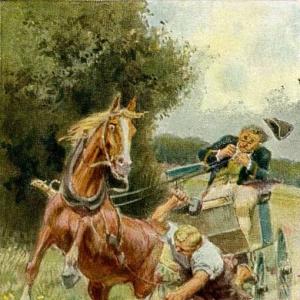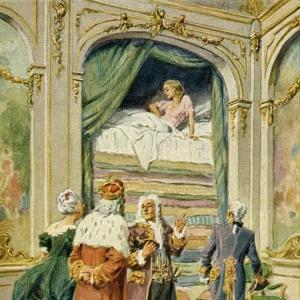Reading time: 10 min
„Ding-dong! Ding-dong!“ rings out from the Bell Deep in the Odense River. And what sort of river is that? Why, every child in Odense Town knows it well. It flows around the foot of the gardens, from the locks to the water mill, under the wooden bridges. Yellow water lilies grow in the river, and brown, featherlike reeds, and the black, velvety bulrushes, so high and so thick. Decayed old willow trees, bent and gnarled, hang far over the water beside the monks‘ marsh and the pale meadows; but a little above are the many gardens, each very different from the next. Some have beautiful flowers and arbors as clean and neat as dolls‘ houses, while some have only cabbages, and in others no attempts at formal gardens can be seen at all, only great elder trees stretching out and overhanging the running water, which in places is deeper that an oar can measure.
The deepest part is right opposite the old nunnery. It is called the Bell Deep, and it is there that the Merman lives. By day, when the sun shines through the water, he sleeps, but on clear, starry, or moonlit nights he comes forth. He is very old; Grandmother has heard of him from her grandmother, she says; and he lives a lonely life, with hardly anyone to speak to except the big old church bell. It used to hang up in the steeple of the church, but now no trace is left either of the steeple or of the church itself, which used to be called St. Alban’s.
„Ding-dong! Ding-dong!“ rang the Bell when it hung in the steeple. But one evening, just as the sun was setting and the Bell was in full swing, it tore loose and flew through the air, its shining metal glowing in the red beams of the sunset. „Ding-dong! Ding-dong! Now I’m going to bed!“ sang the Bell, and it flew into the deepest spot of the Odense River, which is why that spot is now called the Bell Deep. But it found neither sleep nor rest there, for it still rings and clangs down at the Merman’s; often it can be heard up above, through the water, and many people say that it rings to foretell the death of someone-but that is not the reason; no, it really rings to talk to the Merman, who then is no longer alone.
And what stories does the Bell tell? It is so very old. It was cast before Grandmother’s grandmother was born, yet it was scarcely more than a child compared with the Merman. He is a quiet, odd-looking old fellow, with pants of eelskin, a scaly coat decorated with yellow water lilies, bulrushes in his hair, and duckweeds in his beard. He isn’t exactly handsome to look at.
It would take years and days to repeat everything the Bell has said. It tells the same stories again and again, in great detail, sometimes lengthening them, sometimes shortening them, according to its mood. It tells of the olden times, those hard and gloomy times.
Up to the tower of St. Alban’s Church, where the Bell hung, there once ascended a monk, young and handsome, but deeply thoughtful. He gazed through the loophole out over the Odense River. In those days its bed was broad, and the marsh was a lake. He looked across it, and over the green rampart called „The Nun’s Hill,“ to the cloister beyond, where a light shone from a nun’s cell. He had known her well, and he recalled that, and his heart beat rapidly at the thought.
„Ding-dong! Ding-dong!“ Yes, such are the stories the Bell tells.
„One day the Bishop’s silly manservant came up to the tower; and when I, the Bell, cast as I am from hard and heavy metal, swung to and fro and rang I almost crushed his head, for he sat down right under me and played with two sticks, exactly as if they formed a musical instrument. He sang to them, ‚Here I may dare to sing aloud what elsewhere I dare not whisper-sing of all that is hidden behind locks and bolts. It is cold and damp there. The rats eat people up alive! No one knows of this. No one hears of it; even now, for the Bell is ringing so loudly, Ding-dong! Ding-dong!‘
„Then there was a king called Knud. He bowed low before bishops and monks, but when he unjustly oppressed the people of Vendelbo with heavy taxes and hard words, they armed themselves with weapons and drove him away as if he had been a wild beast. He sought refuge in this church and bolted fast the gate and doors. I have heard tell how the furious mob surrounded the sacred building, until the crows and ravens, and even the jackdaws, became alarmed by the tumult. They flew up in and out of the tower and peered down on the multitude below. They gazed in at the church windows and shrieked out what they saw.
„King Knud knelt and prayed before the altar while his brothers, Erik and Benedict, stood guarding him with drawn swords. But the King’s servant, the false Blake, betrayed his master, and when those outside knew where he could be hit, one of them hurled a stone in through the windows, and the King lay dead! Then there were shouts and screams from the angry mob, and cries, too, from the flocks of terrified birds, and I joined them all. I rang and sang, ‚Ding-dong! Ding-dong!‘
„The Church Bell hangs high and can see far around. It is visited by the birds and understands their language. The Wind whispers to it through the wickets and loopholes and every little crack, and the Wind knows all things. He hears it from the Air, for the Air surrounds all living creatures, even enters the lungs of humans, and hears every word and sigh. Yes, the Air knows all, the Wind tells all, and the Church Bell understands all and peals it forth to the whole world, ‚Ding-dong! Ding-dong!‘
„But all this became too much for me to hear and know. I was no longer able to ring it all out. I became so tired and so heavy that at last the beam from which I hung broke, and so I flew through the glowing air down to the deepest spot of the river, where the Merman lives in solitude and loneliness. And year in and year out, I tell him all I have seen and all I have heard. Ding-dong! Ding-dong!“
Thus it sounds from the Bell Deep in the Odense River-at least, so my grandmother has told me.
But our schoolmaster says there’s no bell ringing down there, for there couldn’t be; and there’s no Merman down there, for there aren’t any Mermen. And when all the church bells are ringing loudly, he says it’s not the bells, but that it is really the air that makes the sound! And my grandmother told me that the Bell said the same thing; so, since they both agree on it, it must be true. The air knows everything. It is around us and in us. It tells of our thoughts and our actions, and it voices them longer and farther than the Bell down in the Odense River hollow where the Merman lives. It voices them into the great vault of heaven itself, so far, far away, forever and ever, until the bells of heaven ring out, „Ding-dong! Ding-dong!“
 Learn languages. Double-tap on a word.Learn languages in context with Childstories.org and Deepl.com.
Learn languages. Double-tap on a word.Learn languages in context with Childstories.org and Deepl.com.Backgrounds
Interpretations
Adaptions
Summary
Linguistics
„The Bell Deep“ is a fairy tale written by the renowned Danish author Hans Christian Andersen. Andersen was born on April 2, 1805, in Odense, Denmark, and died on August 4, 1875. He was a prolific writer of plays, travelogues, novels, and poems, but he is best known for his fairy tales. Some of his most famous works include „The Little Mermaid,“ „The Ugly Duckling,“ „The Emperor’s New Clothes,“ and „The Snow Queen.“
Andersen’s fairy tales often contain elements of fantasy, folklore, and moral lessons, and they have been translated into more than 125 languages. His stories have also inspired numerous adaptations, including ballets, plays, and animated films.
„The Bell Deep“ is one of Andersen’s lesser-known fairy tales, but it still showcases his talent for storytelling, weaving together elements of fantasy, history, and morality. The story is set in the town of Odense, Andersen’s birthplace, and centers around the Odense River. The tale combines elements of Danish folklore, such as the existence of a merman living in the river, with historical references, such as the story of King Knud and his betrayal by his servant.
The fairy tale also explores themes like the power of storytelling, the interconnectedness of nature, and the importance of preserving history and heritage. Although „The Bell Deep“ may not be as famous as some of Andersen’s other works, it is a compelling example of his imaginative storytelling and ability to explore complex themes through the lens of fantasy.
There are several interpretations one can derive from „The Bell Deep“ by Hans Christian Andersen:
The power of storytelling: The fairy tale emphasizes the importance of storytelling in connecting people and keeping history alive. The bell serves as a source of companionship and entertainment for the merman, sharing stories of the past that might otherwise be forgotten.
The omnipresence of nature: The tale highlights the interconnectedness of nature and its ability to bear witness to human events. The air, wind, and birds are portrayed as all-knowing entities that observe and carry stories throughout the world. This theme reminds readers of the inseparable relationship between humans and the natural world.
The consequences of betrayal: The story of King Knud and his treacherous servant, Blake, serves as a cautionary tale about the destructive consequences of betrayal. King Knud’s death at the hands of the mob is a direct result of Blake’s disloyalty, reminding readers of the importance of trust and loyalty in relationships.
The passage of time and the impermanence of human structures: The tale demonstrates how time can change the landscape, both physical and cultural. St. Alban’s Church no longer exists, and the world in which the bell once hung has long since vanished. This theme emphasizes the fleeting nature of human constructs and the importance of preserving our history and heritage.
The tension between folklore and rationality: The narrative presents a contrast between the fantastical elements of folklore, represented by the grandmother’s belief in the merman and the bell, and the rational explanations provided by the schoolmaster. This tension invites readers to consider the role of imagination and myth in our understanding of the world and the value of balancing both rationality and wonder in our lives.
Hans Christian Andersen’s fairy tale „The Bell Deep“ has inspired a number of adaptations and retellings over the years, across various forms of media. Here are a few examples.
„The Little Mermaid“: Perhaps the most famous adaptation of „The Bell Deep“ is Hans Christian Andersen’s own „The Little Mermaid.“ While the two stories have different plots, they share many similarities, including a focus on the ocean and themes of sacrifice and transformation.
„The Deep“ (2015): „The Deep“ is a graphic novel series by Tom Taylor and James Brouwer that features a group of explorers who discover a sunken city at the bottom of the ocean. While not a direct adaptation of „The Bell Deep,“ the series shares many thematic similarities, including a focus on the mysteries of the deep sea and the dangers of human curiosity.
„The Bell Deep“ (2019): In 2019, filmmaker Andrew Osborne released a short film adaptation of „The Bell Deep.“ The film follows a diver who becomes obsessed with the sound of a bell ringing from the depths of the ocean, and his journey to uncover its secrets.
„The Bell at the Bottom of the Sea“ (2014): „The Bell at the Bottom of the Sea“ is a play by Canadian playwright David Yee that is loosely based on „The Bell Deep.“ The play explores themes of identity and belonging, as a young woman struggles to come to terms with her family’s history and her own sense of self.
„The Deep End“ (2020): „The Deep End“ is a video game developed by German studio Haus of Divergent that draws inspiration from „The Bell Deep.“ In the game, players take on the role of a deep-sea diver who must explore a mysterious underwater world and uncover its secrets.
Overall, „The Bell Deep“ continues to inspire new adaptations and interpretations across various forms of media, demonstrating the enduring power and relevance of Andersen’s work.
„The Bell Deep“ is a fairy tale by Hans Christian Andersen that tells the story of a mysterious bell and a merman living in the depths of the Odense River. The river is well-known to the children of Odense Town and is home to various plants and creatures. The merman, an odd-looking old fellow, is said to be very old and lives a lonely life at the deepest part of the river, known as the Bell Deep.
The story revolves around a bell that once hung in the steeple of St. Alban’s Church, which no longer exists. One evening, the bell broke free and flew into the river, landing in the Bell Deep. Now, the bell rings to communicate with the merman, sharing stories of the past and keeping him company.
The bell’s stories take listeners back to a time when the church tower was visited by monks and kings. One notable story involves a king named Knud, who sought refuge in the church after being chased away by an angry mob for oppressing his people. His servant, the false Blake, betrayed him, resulting in Knud’s death by a stone thrown through the church window.
The bell claims it can see far and wide, understand the language of birds, and hear the whispers of the wind. The wind, in turn, learns everything from the air, which surrounds all living creatures and knows their every word and sigh. The bell used to share these stories with the world, but it eventually became overwhelmed and found solace in the depths of the river.
Despite the fantastical elements of the tale, the schoolmaster in the story asserts that there is no merman in the river and that it is the air, not the bells, that produces sound. Interestingly, the bell’s own story agrees with the schoolmaster’s claims. The air is omnipresent, knows everything, and continues to carry the stories of our thoughts and actions far beyond the reach of the mysterious bell in the depths of the Odense River.
Hans Christian Andersen’s „The Bell Deep“ offers a multifaceted linguistic landscape that is rich in imagery, symbolism, and thematic depth, typical of Andersen’s style. Here, we’ll consider some aspects of the linguistic analysis of this fairy tale:
Imagery and Symbolism
Descriptive Nature Imagery:
Andersen’s use of nature imagery is vivid and rich. The depiction of the Odense River with its yellow water lilies, brown reeds, black bulrushes, and gnarled willow trees creates an enchanting, almost magical setting. These descriptions not only build the world of the story but also evoke a sensory experience for the reader.
The Bell and the Merman:
The bell itself is a powerful symbol in the story, representing communication and the passage of time. It acts as a vessel of stories and history, echoing the events of the past. The Merman, in contrast, symbolizes isolation and the timeless nature of the natural world.
Light and Sound:
Andersen uses light imagery effectively, particularly in the scene where the bell „flew through the air, its shining metal glowing in the red beams of the sunset. “ The interplay of sound is also prominent, with the recurring „Ding-dong! Ding-dong!“ mimicking the rhythmic chime of a bell and emphasizing themes of memory and history.
Themes and Motifs
Historical Reflection:
The story delves into the past with references to figures like King Knud and the events surrounding the church’s history. This historical depth adds layers to the narrative, offering a commentary on the inevitability of time and the endurance of stories.
Communication with Nature:
Andersen blurs the lines between animate and inanimate with the bell’s ability to „talk“ to the Merman and understand the language of birds and the wind. This motif underscores a harmony or connection between humanity and nature, suggesting a deeper, almost mystical form of communication.
Reality vs. Imagination:
The dichotomy between the grandmother’s tales and the schoolmaster’s rational explanations touches upon the broader theme of folklore versus scientific reality. This theme is embodied in the unresolved mystery of the bell’s existence at the river’s bottom, leaving the reader to ponder the role of belief and imagination in understanding the world.
Narrative Voice:
Andersen employs a storytelling style that is both engaging and accessible, with a narrative voice that blends elements of oral tradition with literary sophistication. The use of a framing device — the narrator recounting what the grandmother told him — gives the story a personal, intimate feel.
Repetition and Rhythm:
Repetition is a key feature in the text, particularly with the onomatopoeic „Ding-dong!“ that punctuates the narrative. This repetition creates rhythm and reinforces the central motifs of ringing bells and the passage of time.
Dialogue and Direct Address:
Andersen uses direct speech, such as the bell speaking, to animate the inanimate and give life to the story’s magical elements. This technique strengthens the fairy tale atmosphere and enhances reader engagement by breaking the boundary between reality and fantasy.
Overall, „The Bell Deep“ is an exemplary tale that showcases Andersen’s ability to weave complex narrative threads with simple, yet powerful language. Through a rich tapestry of imagery, symbolism, and evocative storytelling, Andersen invites readers to explore themes of memory, communication, and the intersection of human and natural worlds.
Information for scientific analysis
Fairy tale statistics | Value |
|---|---|
| Translations | DE, EN, DA, ES |
| Readability Index by Björnsson | 25.5 |
| Flesch-Reading-Ease Index | 84.2 |
| Flesch–Kincaid Grade-Level | 5.4 |
| Gunning Fog Index | 7.7 |
| Coleman–Liau Index | 8.2 |
| SMOG Index | 8.1 |
| Automated Readability Index | 5.5 |
| Character Count | 6.780 |
| Letter Count | 5.222 |
| Sentence Count | 83 |
| Word Count | 1.281 |
| Average Words per Sentence | 15,43 |
| Words with more than 6 letters | 129 |
| Percentage of long words | 10.1% |
| Number of Syllables | 1.620 |
| Average Syllables per Word | 1,26 |
| Words with three Syllables | 60 |
| Percentage Words with three Syllables | 4.7% |

 Facebook
Facebook  Whatsapp
Whatsapp  Messenger
Messenger  Telegram
Telegram Reddit
Reddit















